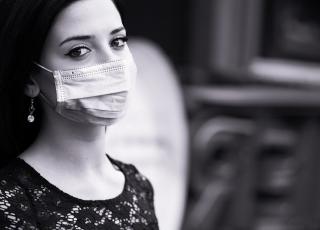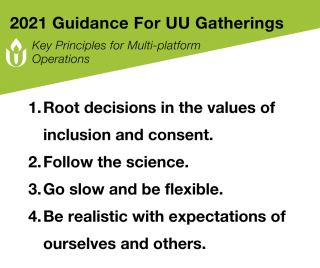Covid-19 Gathering Guidance
The for latest information on COVID from the UUA, please see our new pages:
Originally Published August 20, 2021
Updated in October and December 2021; lightly edited on January 5, 2022
New Variants, Same Precautions

In late 2021, the COVID-19 Virus produced another “variant of concern:” B.1.1.529, named the Omicron variant. It is likely that variants will continue to emerge. For each new variant, it takes time for medical experts to determine how transmissible it is, how severe its effects, how effective existing vaccines are against it, and how best to protect ourselves from it.
We continue to turn to the public health professionals who have been advising us throughout the pandemic. As we learn more about what works and what doesn’t work (or no longer works) to lower the risk of transmission, we will update our recommendations with new protocols. Guidelines about types of masks to wear, safe distancing, air exchanges per hour, etc. are likely to continue to change. It will be harder and harder to for the UUA to offer specific and/or prescriptive guidance, given the variety of circumstances.
As we have tracked transmission numbers via the COVID Act Now website we continue to see high to severe transmission rates in some areas. We still recommend that you sign up for email alerts for changes in your county’s status from COVID Act Now as well as for the surrounding counties so you can more easily track when your transmission rates are rising or falling. We recommend following the guidance for the worst case in your area if nearby counties are rising, even if your particular county is low or moderate.
It is important for the leadership of each congregation to assess the transmission risk for their local community (vaccination rates and rates of spread by county) and particular risk factors for staff and members of the congregational community.
Then, following our Four Principles to Guide Decisions for UU Gatherings (see graphic below, right), assess your potential meeting spaces for size, capacity with physical distancing, adequate ventilation, and outdoor meeting spaces; leaders can make faithful and careful policy.
Recommendations

In August 2021, the UUA consulted the public health professionals who have been advising us throughout the pandemic, and made the UUA following recommendations. Since then, the number of vaccinations, COVID positive test rates, and other factors have shifted in many communities. The UUA recognizes that congregations will need to make their own decisions about risks and safety, based on their community context. These recommendations are most important for areas where vaccinations are low and cases are high.
Upon consulting the public health professionals who have been advising us throughout the pandemic, for now, the UUA strongly recommends:
- For all indoor gatherings, regardless of size, vaccination status, or area transmission risk: Require good ventilation, well-fitted masks, physical distancing of at least 6 ft, reduced occupancy, no singing, and no food, nor drinks.
- Require well-fitted masks for all large outdoor events, for any outdoor event where unvaccinated children or other vulnerable people are included, and for outdoor gatherings of any size in counties where transmission is Very High or Severe (per the COVID Act Now data).
- Until children below age 12 can vaccinated, hold religious education activities and multi-age programs outdoors. If children are indoors for any purpose (like using the restroom), ensure excellent ventilation, masking, physical distancing, and reduced room occupancy.
- In areas where transmission risk is Very High or Severe, (per the COVID Act Now data), suspend all large, in-person (indoor and outdoor) gatherings such as worship, concerts, or fundraisers.
- In areas where transmission risk is Low, Medium, or High (per the COVID Act Now data), small and mid-size gatherings, including limited-attendance worship, may be reasonably safe if indoor precautions for masking, ventilation, physical distancing and high vaccination rates are followed.
- Create an expectation that vaccinations are required for everyone who is eligible. Work to have the highest vaccination rate possible in your community. We support requiring vaccinations for staff, lay leaders, and anyone spending time with children.
It is important for congregations to regularly assess the transmission risk for their local and surrounding areas as determined by trusted health authorities and the particular risk factors for staff and members of the community.
For Congregations in Counties Labeled High Risk
If COVID Act Now considers your county and/or surrounding counties to be at high risk, but not very high or severe, we encourage your leadership to pay close attention to the infection trends and be prepared to adjust your plans as needed.
The three biggest factors to monitor are Daily New Cases, Infection Rate, and Test Positivity. If any of these is moving upward in your community, your area’s risk may soon be considered very high or severe and it may be important to take more restrictive precautions to help prevent further transmission in your area.
You can subscribe to real-time alerts from COVID Act Now by scrolling to the bottom of any page on their website.
You Are Not Alone
We all know the importance of continuing to minister to and provide for the spiritual needs of our communities, maintaining inclusion for all and mitigating risks for our people, and larger communities.
The UUA is here to support you in that work and we should all make space to support those tasked with making these decisions and plans in our congregations and communities.
In particular, our regional staff is always available for your leaders to listen to your concerns and help talk through your options. If your head is spinning over the changing nature of the pandemic and all the needed adjustments, please reach out to your regional staff for a conversation.